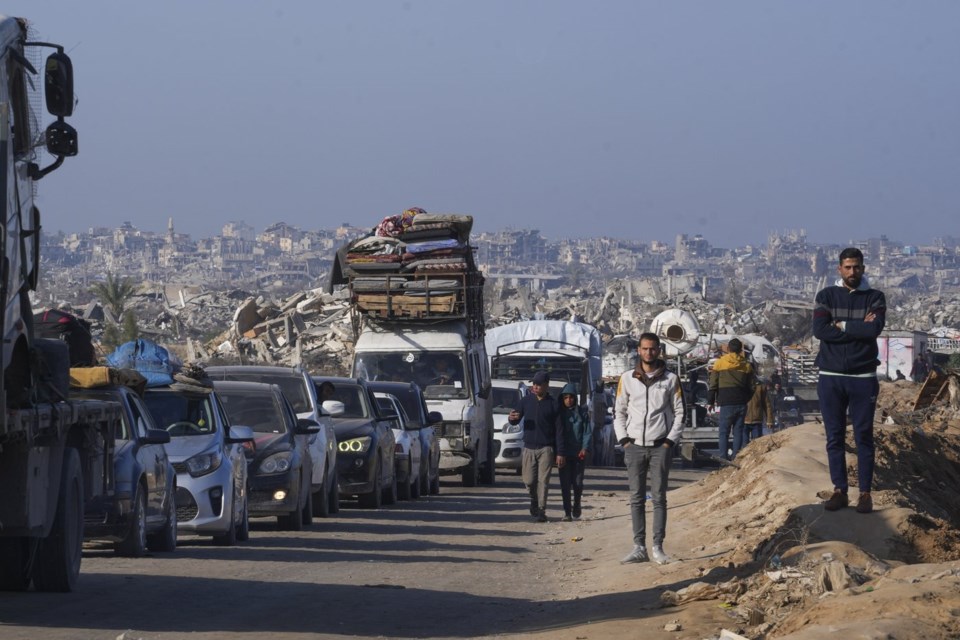CAIRO (AP) — A top Hamas official says the militant group will free six living Israeli hostages on Saturday and return the bodies of four others on Thursday, a surprise acceleration in releases that apparently comes in return for Israel’s allowing mobile homes and construction equipment into the devastated Gaza Strip.
The six are the last living hostages set to be freed under the ceasefire’s first phase. The warring sides have yet to negotiate the second and more difficult phase, in which Hamas would release dozens more hostages in exchange for a lasting ceasefire and an Israeli withdrawal.
Hamas leader Khalil al-Hayya, in prerecorded remarks released Tuesday, said the “Bibas family” would be included in the handover of four bodies, apparently referring to Shiri Bibas and her two young sons, Ariel and Kfir, who for many Israelis embody the captives' plight.
Israel has not confirmed their deaths, and the prime minister's office urged the public not to distribute “photos, names and rumors” after the announcement by Hamas.
"In the past few hours, we have been in turmoil,” surviving members of the Bibas family said in a statement released Tuesday by a group representing the relatives of hostages. “Until we receive definitive confirmation, our journey is not over.”
Israel has said it was gravely concerned about the Bibas family, while Hamas said they were killed in an Israeli airstrike early in the war. Yarden Bibas, the husband and father, was kidnapped separately and released this month.
Kfir, who was 9 months old at the time, was the youngest hostage taken in Hamas’ Oct. 7, 2023, attack that triggered the war. A video of the abduction showed Shiri swaddling her redheaded boys in a blanket and being whisked away by armed men.
The six living hostages slated for release are Eliya Cohen, Tal Shoham, Omer Shem Tov, Omer Wenkert, Hisham Al-Sayed, and Avera Mengistu, the Hostages and Missing Families Forum said Tuesday. Cohen, 27, Shem Tov, 22, and Wenkert, 23, were abducted from a music festival. Shoham was taken from the hard-hit community of Kibbutz Beeri. Al-Sayed, 36, and Mengistu, 39, have both been held since crossing into Gaza years before the Oct. 7 attack.
An Israeli official, speaking on condition of anonymity in line with regulations, said Prime Minister Benjamin Netanyahu had agreed to allow long-requested mobile homes and construction equipment into Gaza as part of efforts to accelerate the hostages' release.
Hamas last week threatened to hold up releases, citing the refusal to allow in mobile homes and heavy equipment among other alleged violations of the truce.
Israel began allowing entry of rubble-removing equipment Tuesday, according to an Associated Press journalist in southern Gaza and Egypt’s state-run media. The AP journalist saw two bulldozers clearing rubble in an area near the Palestinian side of the Rafah border crossing. An Egyptian driver told AP that dozens of bulldozers and tractors were at another crossing, awaiting Israeli permission to enter.
Israel is expected to continue releasing hundreds of Palestinian prisoners, including many serving life sentences for deadly attacks, in exchange for the hostages. Others were detained without charge. During the first phase, Israel is also due to release all women and children seized from Gaza since the war began.
Palestinians want to stay in their homeland
The ceasefire that began in mid-January has paused the deadliest fighting ever between Israel and Hamas, surged aid into devastated Gaza and allowed hundreds of thousands of Palestinians to return to their homes as Israeli forces withdrew from much of the territory.
Israelis and Palestinians marked 500 days of war on Monday.
Major challenges are ahead. Israel’s government says it wants to eliminate Hamas’ military and governing capabilities in Gaza. But the militant group quickly reasserted its control of the territory during the ceasefire despite losing leaders and many fighters.
In addition, U.S. President Donald Trump ’s proposal to permanently remove Gaza's population of some 2 million Palestinians so the U.S. can redevelop the territory has been rejected by the Arab world and by the Palestinians, who say they want to stay in their homeland. Egypt is working on a counter-plan to rebuild without moving Palestinians.
Israel has embraced the plan, and it and the Trump administration have emphasized they share the same goals in the war.
Israelis were horrified by the sight of three emaciated hostages in an earlier release this month, and revelations about hostages being held alone, barefoot or in chains have increased the pressure on Netanyahu's government to push ahead with the ceasefire’s next phase. A number of Palestinians released from Israeli prisons have shown emaciation, and some have reported abuses including beatings.
Fears fighting will resume
The deal's first phase calls for Hamas to gradually release 33 Israeli hostages, eight of whom are believed to be dead. So far, 19 living Israeli hostages have been released in the current phase, in addition to five Thai farmworkers who were abducted. If this week's releases go as planned, four bodies will remain and are set to be returned next week.
Hamas-led militants would still hold some 60 captives, around half believed to be dead.
The ceasefire's current phase runs until the beginning of March, and there are fears that fighting will resume. Talks on the second phase were to start early this month.
The militants killed some 1,200 people, mostly civilians, and abducted around 250 in the Oct. 7 attack. More than half the captives have been released in ceasefire agreements and other deals, while eight have been rescued in military operations.
Israel’s air and ground war killed over 48,000 Palestinians, mostly women and children, according to Gaza’s Health Ministry, which does not say how many were combatants. The offensive destroyed vast areas of Gaza and displaced most of its population of 2.3 million.
___
Melzer reported from Nahariya, Israel.
___
Follow AP’s war coverage at https://apnews.com/hub/israel-hamas-war
Samy Magdy And Natalie Melzer, The Associated Press



